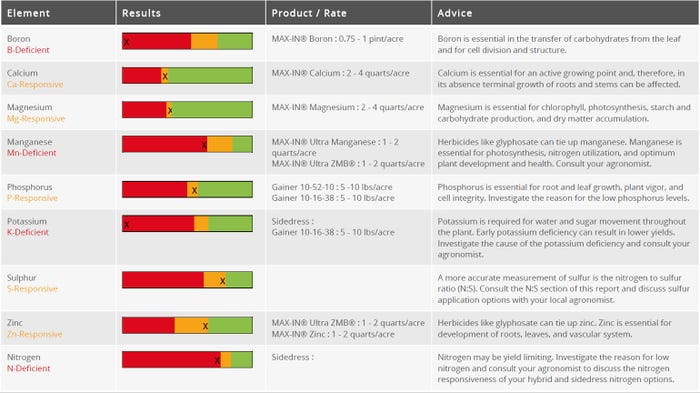
Editor’s note: This is the third in a series of stories about tissue testing and micronutrients. Part 1 discussed micronutrient demands during the growing season, and Part 2 explained how to pull tissue samples.
Your tissue sample report is back from the lab … but what does it all mean? Labs may provide slightly different report formats, says Decatur farmer Mat Muirheid, adding that some labs may color-code the report for easier interpretation.
Reports show four ranges and provide recommendations on whether or not the crop will respond to micronutrient applications, says Jason Haegele, a WinField United agronomist.
Here’s a quick rundown from Haegele on how to read your lab report.
• Deficient range: There’s not enough gas in the tank. There is so little of the micronutrient that the crop shows visual symptoms, like necrosis or chlorosis. Where and how the symptoms appear depends on the nutrient, Haegele explains. Zinc deficiencies appear on new leaves due to limited mobility in the plant. Micronutrient-deficient crops may have already lost yield potential, but applying fertilizer could help negate further loss.
• Responsive (low) range: The crop could use a little fuel. You may not notice anything symptomatically wrong with your crop, but yields could be impacted by slight deficiencies. The crop is right on the sufficiency line and would respond to a foliar application of the deficient micronutrient.
• Adequate (sufficient) range: The gas tank is full. This is right where you want your plants to be, and your fertilizer management program is spot-on.
• Excessive range: The gas tank is overflowing. The micronutrient level is so high that it could lead to toxicity and death of the plant.
In Decatur, Muirheid is ready for another year of fine-tuning his fertility program. “It’s another tool in the toolbox,” he says. “It gives you an idea of the micronutrients to work on to increase yield.”
Farmers can address deficiencies individually with single-micronutrient foliar applications, like zinc, or with a blended mix like ZMB, which is zinc, manganese and boron, Muirheid explains.
Haegele adds that you don’t want to apply more micronutrients if the crop already has adequate levels to avoid toxicity. “Any nutrient has the potential to cause a negative effect in extremely high amounts,” he says. “We typically don’t see that in Illinois.”
There’s a slight learning curve for tissue sampling, interpreting results and making decisions on whether or not to apply additional nutrients based on different nutrient demands and various crop stages, Haegele notes. He recommends farmers work with their agronomist for advice on next steps.

TEST RESULTS: Tissue test results will look something like this report, which came from a WinField United demonstration plot. The plot had not received special fertility treatments, and the report revealed low nutrient levels across the board.
About the Author(s)
You May Also Like




